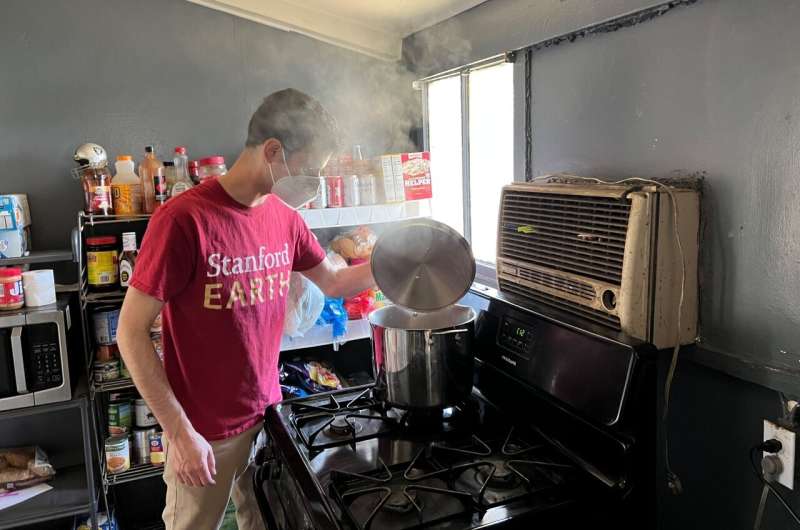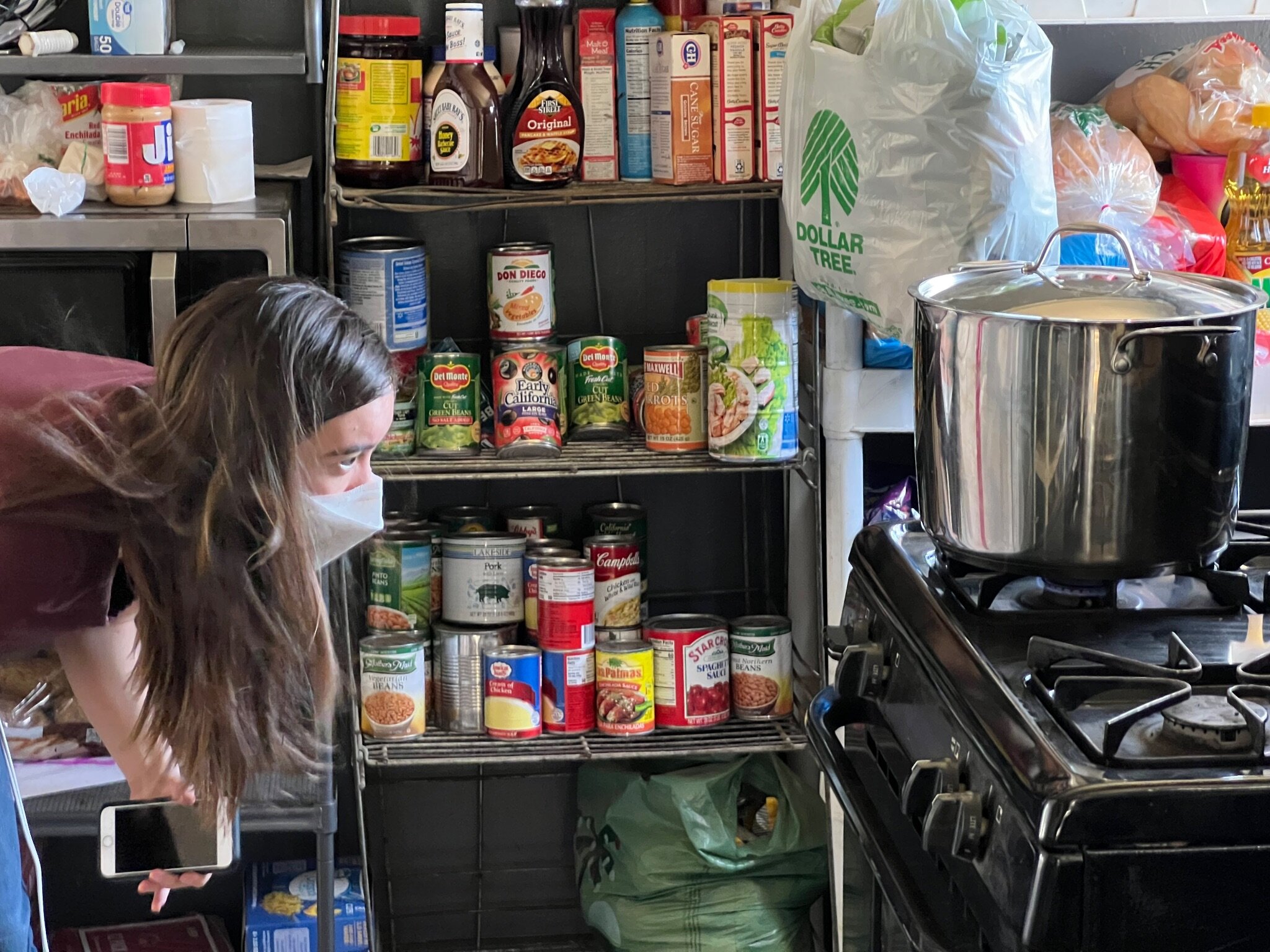A study of air pollution in U.S. homes found that households with gas or propane stoves regularly breathe unhealthy levels of nitrogen dioxide.
“I didn’t expect to see pollutant concentrations breach health benchmarks in bedrooms within an hour of gas stove use, and stay there for hours after the stove is turned off,” said Stanford Doerr School of Sustainability Professor Rob Jackson, senior author of the paper appearing in Science Advances.
Pollution from gas and propane stoves isn’t just an issue for cooks or people in the kitchen, he said. “It’s the whole family’s problem.”
Among other negative health effects, breathing high levels of nitrogen dioxide, or NO2, over time can intensify asthma attacks and has been linked to decreased lung development in children and early deaths.
Although most exposure to NO2 is caused by cars and trucks burning fossil fuels, the researchers estimate that the mix of pollutants coming from gas and propane stoves overall may be responsible for as many as 200,000 current childhood asthma cases. One quarter of these can be attributed to nitrogen dioxide alone, according to the paper’s authors, who include scientists from Central California Asthma Collaborative, PSE Healthy Energy, and the Harvard T.H. Chan School of Public Health.
“We found that just how much gas you burn in your stove is by far the biggest factor affecting how much you’re exposed. And then, after that, do you have an effective range hood—and do you use it?” said lead study author Yannai Kashtan, a Ph.D. student in Earth system science.
Little room for additional exposure
Beyond asthma cases, the long-term exposure to NO2 in American households with gas stoves is high enough to cause thousands of deaths each year—possibly as many as 19,000 or 40% of the number of deaths linked annually to secondhand smoke. This estimate is based on the researchers’ new measurements and calculations of how much nitrogen dioxide people breathe at home because of gas stoves and the best available data on deaths from long-term exposure to outdoor NO2, which is regulated by the U.S. Environmental Protection Agency.
The death toll estimate is approximate in part because it does not factor in the harmful effects of repeated exposure to extremely high levels of nitrogen dioxide in short bursts, as occurs in homes with gas stoves. It also relies on past studies of health impacts from nitrogen dioxide encountered outdoors, where additional pollutants from vehicles and power plants are present.
The researchers used sensors to measure concentrations of NO2 throughout more than 100 homes of various sizes, layouts, and ventilation methods, before, during, and after stove use.
They incorporated these measurements and other data into a model powered by National Institutes for Standards and Technology (NIST) software known as CONTAM for simulating airflow, contaminant transport, and room-by-room occupant exposure in buildings.
This allowed them to estimate nationwide averages and short-term exposures under a range of realistic conditions and behaviors, and cross-check model outputs against their home measurements.

The results show that nationwide, typical use of a gas or propane stove increases exposure to nitrogen dioxide by an estimated 4 parts per billion, averaged over a year. That’s three-quarters of the way to the nitrogen dioxide exposure level that the World Health Organization recognizes as unsafe in outdoor air. “That’s excluding all outdoor sources combined, so it makes it much more likely you’re going to exceed the limit,” said Kashtan.
Understanding how gas stoves affect health
The study is the latest in a series from Jackson’s group at Stanford looking at indoor air pollution from gas stoves. Earlier studies documented the rate at which gas stoves emit other pollutants, including the greenhouse gas methane and the carcinogen benzene.
But to understand the implications of stove emissions for human health, the researchers needed to find out how much pollutants spread through a home, build up, and eventually dissipate. “We’re moving from measuring how much pollution comes from stoves to how much pollution people actually breathe,” said Jackson, who is the Michelle and Kevin Douglas Provostial Professor in Earth System Science.
With any fuel source, particle pollution can rise from food cooking in a hot pan. The new research confirms that food emits little or no nitrogen dioxide as it cooks, however, and electric stoves produce no NO2. “It’s the fuel, not the food,” said Jackson. “Electric stoves emit no nitrogen dioxide or benzene. If you own a gas or propane stove, you need to reduce pollutant exposures using ventilation.”
Home size matters
Even in larger homes, concentrations of nitrogen dioxide routinely spiked to unhealthy levels during and after cooking even if a range hood was on and venting air outdoors. But people who live in homes smaller than 800 square feet—about the size of a small two-bedroom apartment—are exposed to twice as much nitrogen dioxide over the course of a year compared to the national average, and four times more compared to those living in the largest homes, upwards of 3,000 square feet.
Because home size makes such a difference, there are also differences in exposure across racial, ethnic, and income groups. Compared to the national average, the researchers found long-term NO2 exposure is 60% higher among American Indian and Alaska Native households, and 20% higher among Black and Hispanic or Latino households.
This exposure to indoor air pollution from gas stoves compounds the fact that exposure to outdoor sources of nitrogen dioxide pollution, such as vehicle exhaust, is also typically higher among people in poorer, often minority, communities.
“People in poorer communities can’t always afford to change their appliances, or perhaps they rent and can’t replace appliances because they don’t own them,” Jackson said. “People in smaller homes are also breathing more pollution for the same stove use.”
More information:
Yannai Kashtan et al, Nitrogen dioxide exposure, health outcomes, and associated demographic disparities due to gas and propane combustion by U.S. stoves, Science Advances (2024). DOI: 10.1126/sciadv.adm8680. www.science.org/doi/10.1126/sciadv.adm8680
Citation:
People with gas and propane stoves breathe more unhealthy nitrogen dioxide, study finds (2024, May 3)
retrieved 3 May 2024
from https://medicalxpress.com/news/2024-05-people-gas-propane-stoves-unhealthy.html
This document is subject to copyright. Apart from any fair dealing for the purpose of private study or research, no
part may be reproduced without the written permission. The content is provided for information purposes only.
